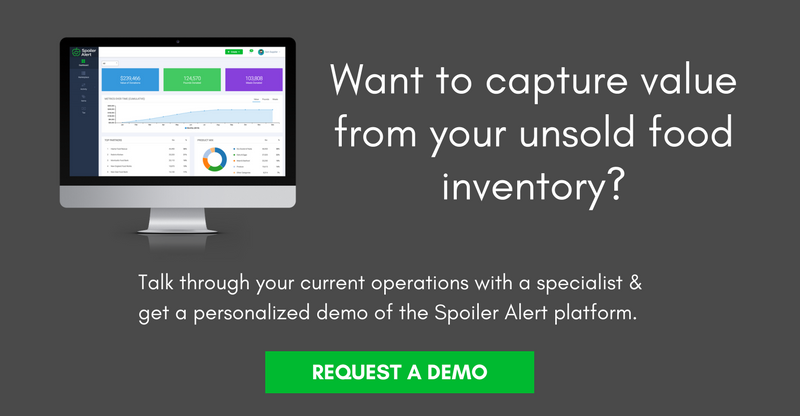.jpg?width=640&name=WasteExpo%202017%20Blog%20(1).jpg)
Last week, some 13,000 individuals convened in New Orleans for the 49th annual WasteExpo. The event, organized by Waste360, brings together public and private entities from the waste and recycling space to network, educate, and learn from one another about new innovations and best practices in the industry.
What’s exciting for us is that a growing number of professionals are evaluating the role and impact that food recovery and organics management play in this space. And rightfully so: according to the U.S. EPA, food waste and other organic material represented the single largest component of municipal solid waste (MSW) in 2014.
Last year, WasteExpo introduced a new conference track called the Food Recovery Forum focused on bringing together food businesses, municipalities, government representatives, and members of the nonprofit and hunger relief communities to share innovations up and down the EPA’s Food Recovery Hierarchy.
We had the opportunity to attend, learn, and participate in the dialogue, as well as present on a panel that focused on the role data and technology can (and will) play in supporting food recovery and organics diversion.
Below are highlights from speakers, reflections on our panel, as well as our take on how enterprise software can support food waste innovation.
Food Recovery Forum
The Food Recovery Forum track featured over 50 speakers spread out across 15 sessions, collectively tackling one of the most challenging and complex problems of our time - bridging the environmental and social complexities of food waste mitigation. Of note:
- Private Sector Innovation: Gail Tavill of Conagra Brands presented examples of product innovations created from previously wasted manufacturing byproducts: for example, a blended pudding flavor that is made when transitioning flavors during production, which the company donates. Separately, Sodexo USA highlighted a number of key initiatives underway, including why it is important to collaborate and work with vendors throughout the supply chain on food waste reduction.
- Industry Collaboration: Meghan Stasz from the Grocery Manufacturers Association (GMA) and Michael Hewett from Publix highlighted the Food Waste Reduction Alliance’s (FWRA) collaborative efforts around education, case study sharing, and metric tracking.
- Nonprofit Leadership: Karen Hanner with Feeding America highlighted its investment in MealConnect as a tool to support recovery of prepared foods from restaurant and foodservice providers, most notably in conjunction with Starbucks’ FoodShare initiative.
- Volunteer Food Rescue: Regina Northouse, Executive Director of the Food Recovery Network (FRN), spoke about the progress that FRN has made in expanding to more than 200 college campuses, while Leah Lizarondo from 412 Food Rescue shared her team’s success in building a volunteer driven, tech-enabled food rescue program in Pittsburgh.
- Organics Management: For perspective on food unfit for human consumption, Ryan Cooper from Rubicon Global spoke about some of his team’s work at distribution centers and within supermarkets. Waste Dive provides additional context on Rubicon’s innovations presented at the conference.
Digging in on Data
A growing area of interest is the role that technology plays in supporting food recovery and organics diversion. Spoiler Alert had the opportunity to participate in a panel alongside Abbe & Associates, Organix Recycling, Copia, BlueCart, and SCS Engineers. The panel was organized and moderated by Geoff Aardsma, Vice President of Client Services at Enevo, a waste tech company focused on utilizing data to create efficiencies, cut the cost of waste collection, and incentivize recycling.
We caught up with Geoff after the panel to learn more about Enevo’s motivations for organizing the session and his views on tech’s role in food recovery and waste diversion. Geoff tells us that Enevo is constantly seeking knowledge on the various pressures that haulers experience. This panel was an opportunity for Enevo to promote the sharing of knowledge on the various outlets for food waste, and how geographic influences affect performance.
Geoff went on to emphasize that increasing the quantity and quality of data will allow waste generators to better understand behavior and identify best practices. “Our mission is to remove the assumptions and manual work that restrict improvements in waste management,” he concluded. For this to happen, consistent, high-quality data is necessary.
The Role Enterprise Software Can Play
We couldn’t agree more. From our perspective, it is essential to incorporate relevant operational and business trends, such as total inventory losses and business sales metrics, when evaluating the success (or failure) of a food recovery program. It can be exciting to see a chart that highlights growth in food donations over time. But, without comparing donations to overall inventory losses and total sales, these absolute figures in silo can be misleading!
To overcome this, we recommend the development of a “shrink-to-sales ratio” as well as a “recovered-to-shrink ratio”. The example below shows that losses as a percentage of sales are actually increasing (highlighting a sales and merchandising problem), and recovery rates as a percentage of recoverable volume are actually decreasing (highlighting a warehouse or store operations problem). Not seeing the complete picture can result in misdiagnosing problems and wasted resources.
Where does Spoiler Alert fit in?
Knowing where to spend your time and efforts is where enterprise software can come into play. We believe a better understanding of data enables greater optimization of outlets. Spoiler Alert’s enterprise software allows food manufacturers and distributors to get a better handle on their food recovery and waste diversion efforts, which enables and drives greater engagement across key stakeholders. Visit us here to learn more about scheduling a demo.
.png?width=250&name=SpoilerAlert_WhiteLogo_LeftStacked%20(7).png)
